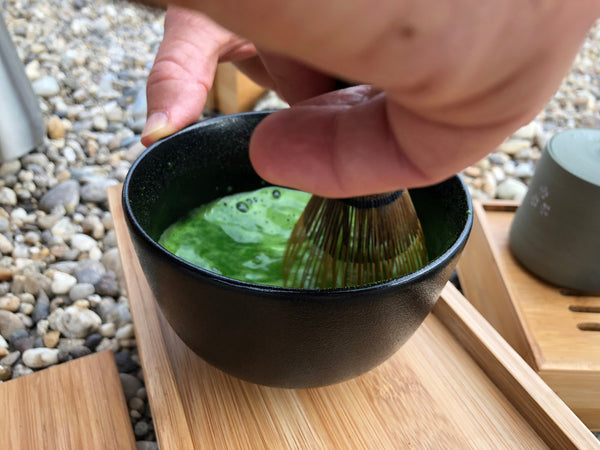What is matcha tea?
Matcha is a powdered green tea (variation) of Japanese origin, grown and processed in a special way (partly by shading the tea plant). It was first consumed by Zen Buddhist monks in the 9th century to support their meditation.
Matcha is an essence, a special tea powder that has been used in the Japanese tea ceremony (Cha no Yu 茶の湯 or Cha Do (Sa Do) 茶道) for over 1000 years. It is mixed with water using a bamboo brush (Japanese: chasen) and consumed ceremonially, usually from a beautiful tea bowl (Japanese: chawan). Nowadays, matcha also appears in other drinks and desserts, but this is not the 'ceremonial' matcha, but the so-called 'kitchen' matcha, which is grown and processed completely differently.
A brief history of matcha tea
The custom of mixing powdered tea with water and consuming it was brought to Japan from China by Zen Buddhist monks in the 7th century.
In China, tea plants were not shaded, so back then it must have had a completely different taste and color than what we now know as Japanese Matcha tea. Perhaps it was a little closer to the white tea type.
12th century - Eisai - Kyoto
Sweet-tasting matcha tea from shaded plantations is a true "Japanese invention".
In Japan, it was only popular in temple and royal circles for a long time, and it took a few hundred years for it to become more popular.
In the 12th century, a Zen monk named Eisai - who also returned from a study trip from China - wrote a book about the beneficial physiological effects of tea (entitled 'Kissa Youjoki' = 'Tea for Health') and also planted tea bushes in several places in the country, including in Toganoo near Kyoto, where the Kozan-ji temple and its tea garden can still be seen today.
This beautiful place also has a personal meaning for us - in addition to the fact that we visited it in 2019: the care of this historic tea garden is entrusted to the 'Yoshida' family, whose matcha teas you can meet and taste with us.
Influenced by Eisai's tea book, the consumption of matcha began to spread, but mostly only among the upper classes.
Uji - the "home of matcha tea"
Soon, tea bushes were also planted in Uji, taking advantage of the favorable tea-growing conditions here.
The wealthy held tea competitions, blind tastings, where Uji tea - as the "real tea" (hon-cha) - had to be selected from the rest, which were simply called "not tea" (hi-cha).
To this day, Uji tea is one of the most prestigious of all tea producing areas.
The matcha ceremony was reformed in the 16th century by 'Sen no Rikyu' - a tea master who had great influence even in royal circles - who broke with luxurious customs and returned to naturalness. He prioritized simple beauty over the pursuit of perfection. This became 'wabi sabi', a clean, almost melancholic attitude to life. This was also reflected in the simpler tea utensils and the puritanical design of the tea room. Book recommendation about wabi sabi here.
Differences between consuming fiber tea and port tea
One of the main differences between consuming loose teas and matcha (powdered tea) is that with matcha we consume almost the entire leaf, while with loose tea we make a decoction that we strain.
It's almost because the woody parts of the leaf are removed and the tender part of the leaf is used when grinding the tea. (This is called ' tencha ')
Today, it is starting to spread all over the world and is gaining more and more popularity - as an important element of health preservation. Well-known coffee and ice cream companies made it fashionable in the 20th century, but due to the large quantity demand, this cannot be the same as the tea from small producers intended for tea ceremonies.
Matcha tea to replace coffee?
Many people use it as a coffee substitute, to invigorate them, and consume it daily, enjoying the peace of their little daily ritual.
A new category has been born: ' culinary grade ' matcha. These can be used in creative ways, for example in lattes, drinks, and sweets.
Both have their place in the world, but anyone who is even slightly open to Japanese culture should definitely start with traditional matcha. There is a choice here too: it is worth trying more and asking for advice and information in tea specialty shops regarding the origin, harvest time and place of production of the matcha tea sold there.
What matcha is not - it's important to clarify
Matcha is not yet a protected product of origin. (But the Japanese are working on it, as far as we know.)
Green tea powder from countries outside Japan or from Japan is not matcha, as the processing steps are different. In Japanese, it has a separate name: ' funmatsucha '.
The raw material for matcha is called ' tencha ' (*see below) which is untwisted and does not contain any stems or other leaf parts other than the flesh of the leaf. Green tea powder, on the other hand, is ground green tea.
It may be good in cookies, but when consumed on its own, we can expect a much more bitter "experience" than matcha.
We cannot call matcha anything that contains any coloring agents, milk powder, or sugar. The green color of matcha is solely the result of shaded cultivation and careful processing.
Two types (categories) of matcha
Matcha can therefore be divided into two main categories:
1. Ceremony matcha
Carefully processed, ground from tencha, pure origin. For consumption on its own only. (other added things only mask its values) It is ground with slow-rotating granite mills.
There is a wide selection within this category, determined only by personal taste or the contents of our wallet.
Some can be used to make thin tea (usucha), some to make thick tea (koicha), and some can be used to make both.
Among the ceremonial matchas, those that come from Uji (Kyoto Prefecture) stand out.
These generally surpass their counterparts from other growing areas in terms of richness of flavor.
Although tea farmers in several other growing areas of Japan are also trying to produce umami-rich tea, surprising specialties are being created.
Matcha tea “blends”
There can be big differences in taste and aroma between different tea blends and mixtures. It depends on what level of tea the maker or producer intends it to be. Entry-level, everyday matcha, or almost exclusively a festive tea for special occasions.
Can it be used to make koicha (thick tea) or just usucha, or is it suitable for both? These all determine the price of matcha tea.
2. Kitchen matcha
You could say it is an industrially grown and processed product.
Here too we find several categories that can be very different in color and taste.
It is not ground with slow-rotating granite mills, but in a different way, in a kind of mixer - therefore it usually has coarser grains than ceremonial matcha.
First, the flavors are assembled from leaves from different locations, and then the whole thing is ground. This is done in larger quantities.
This blend is usually designed for sweet, milky drinks, so it can have a more bitter taste on its own. Here too, it's worth tasting and comparing several to find the right one for you.
You can find our porta for desserts, matcha latte and other drinks here.
How is matcha tea made? (tea ceremony tea)
Before picking, the entire tea plantation is shaded for about 2-3 weeks (the same applies to the “great treasure” in tea, “gyokuro”).
This slows down photosynthesis, which results in a beautiful green color and leaves rich in the amino acid Theanine. This is what gives it a full-bodied, rich, sweet flavor.
The harvest is usually in early to mid-May . It is harvested by hand or machine. (only the best matcha comes from hand picking). A short (15-20 second) steaming process typical of Japanese teas follows, which helps preserve the bright green color and nutritional value of the leaves. Then, unlike other types of loose tea, the leaves are not rolled and crushed , but are slowly spread out in several stages, cooled and dried, and then turned over in a drum-like machine, where the stems and leaf veins are separated from the leaf pulp. The remaining leaf pulp is collected: this is called ' tencha '. This is the raw material for matcha.
Tencha, the raw material for matcha powder
Tencha is rested and stored for up to several months (since it is still too fresh and raw), then leaves from different growing areas are mixed in a specific ratio (this is done by a skilled blender), and finally ground using slow-rotating granite mills (preferably in the dark), usually only when ordered.
Tencha is very sensitive, and light and heat can weaken its quality.
After grinding, the grain size will be around 5-10 microns. (1 mm = 1000 microns) A granite mill grinds just one box of tea, i.e. 40 gr, in 1 hour.
Matcha is almost always a blend of leaves from different regions and/or plant varieties.
The ceremonial matcha is a small masterpiece in its own right, created with great expertise by a master.
They even gave him a stage name.
Effect of matcha tea
You shouldn't expect miracles from consuming matcha unless you make other lifestyle changes.
Proper nutrition, exercise, meditation and rest are equally important.
Despite this, the beneficial effects are not negligible. For example:
- Extremely high in antioxidant content (catechins)
- The invigorating effect lasts longer due to the slower absorption of caffeine
- We can also feel its slightly calming effect due to the amino acid L-Theanine it contains.
- The content of vitamin C, vitamin E and minerals is also not negligible.
- Contains beneficial fiber (since the entire leaf is consumed)
- Speeds up metabolism
How much of it can I consume?
1-2 times a day - our recommended amount. This means one and a half to two grams of matcha per serving. (For Koicha , 4.5-5 grams!).
It's worth eating a little food beforehand, because the rawness of matcha can be difficult to digest, especially for people with sensitive stomachs or those who are otherwise cold.
Also, pay attention to drinking enough water! (this is also true in general)
How do I choose between the different porteas?
The word “matcha” is often seen on any powdered green tea without a designation of origin or quality, which has a bitter taste and is yellowish-brown or grayish in color. Avoid these!
Choose matcha that comes from a reliable source , can be traced back to its origin, and may even provide some background information about the product's manufacturer, producer, or place of production.
Preferably within the 1-1.5 year warranty period.
As mentioned above, not all matcha is suitable for lattes, desserts, or just plain drinking.
This is a very important point.
We recommend visiting a specialty tea shop for tea and avoiding the "green tea powders" that are sold on the shelves of large stores.
Making matcha tea - Balázs made a video, you can watch it on YouTube.
We have already discussed above that when making matcha, we consume the entire (stemless) tea leaf, along with all its nutritional value.
Ceremony matcha: It is worth using 75-80 degrees Celsius, clean spring water or filtered water to prepare it! (Norda; Nestlé Vera; Szigetközi mineral water; Lajosforrás water, etc.) It is important that the water used for tea has a low (60-200 mg/l.) mineral content.
The tools needed for preparation are: a bamboo brush (chasen) (with brush holder), a bamboo spoon (chasaku) and a matcha bowl (chawan). Alternatively, a tightly woven sieve.
I found a Matcha set in the store, which contains all the necessary tools needed to make Matcha.
Preheat the chawan, swirl the brush in the warm water. Wipe the bowl dry. Measure the appropriate amount of matcha into it:
Usucha or Koicha?
Weak tea - Usucha
1.5-2 grams of tea powder (1.5 cups) and 70 ml of water.
Thick tea - Koicha
3-4 grams of tea powder and 50 ml of water. (Only tea specifically recommended by the manufacturer for making koicha should be prepared in this latter way.)
If you have the means, sieve the tea powder; if not, you can make a paste with less water (this is not a traditional preparation method, but it can be used to prevent clumping).
Once the water has been added to the tea, with a relaxed shoulder, and with a loose but quick wrist movement, make a “W” pattern with the brush, and stir the tea with the water until frothy for about 20-30 seconds. Do not press the brush too hard on the bottom of the chawan, just lightly touch it.
After use, rinse your bamboo brush with clean water and place it on the holder so that its shape remains beautiful for a long time .
Let's drink our tea attentively!
After drinking tea, clean your tea making tools, chawan. Put the brush back in its holder so that it retains its shape for a long time.
How do I store matcha?
It should be protected from light, heat, moisture and odors ! It is only worth keeping it in the refrigerator if it cannot absorb other odors and then we have time to wait until it warms up to room temperature before consuming. Otherwise, the moisture in the air will condense on the micron-sized, cold leaf pieces.
Matcha tea – and all tea – is sensitive to environmental influences .
The tea ceremony
The goal is to experience the moment as fully as possible. Hospitality, making tea for the guest.
Its basic principles since the 16th century:
harmony (和wa ), respect (敬kei ), purity (清sei ), and tranquility (寂jaku )
Every little detail counts: the colors, the sounds, the tools, the seasonal message of the wall scroll, etc.
The Japanese tea ceremony always highlights the simple beauty and depth of the present moment. It can be a shorter tea gathering ( chakai (茶会)) or a more formal, longer tea event (chaji (茶事). The latter includes a multi-course meal and serves thick tea (koicha) and later thin tea (usucha).
Japanese tea ceremony can be learned in schools established for this purpose and under Japanese supervision around the world.
If we want to create our own (non-traditional) tea ceremony, we should prepare ourselves properly: time, equipment, undisturbed environment, dedicated time, good tea, and put away the phone.
First, let's examine and define for ourselves what our internal environment is like.
Let's start paying attention to our breathing, our posture, and our movements.
Don't think this is easy or self-evident!
A very small percentage of our daily functioning - including speech and body movements - is done consciously.
If we have mindfulness of the body and internal environment, then we try to maintain all of this while also allowing the external environment in: sounds, sights, smells.
Let's try to keep all of this in mind while making matcha.
To experience this more deeply is a matter of long practice. It is a beautiful journey.



